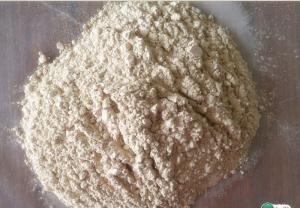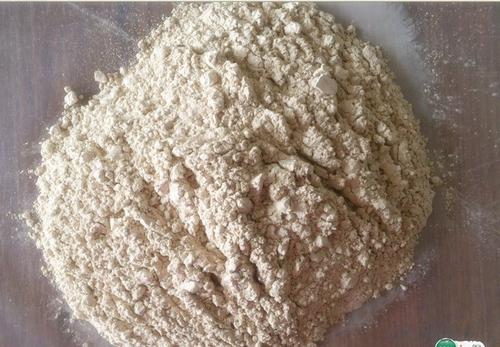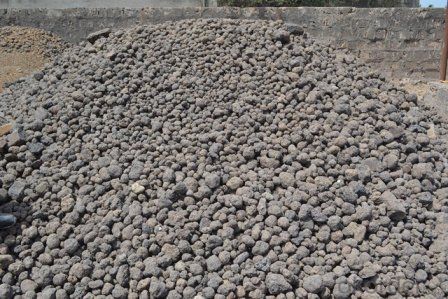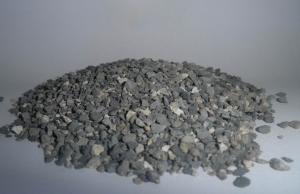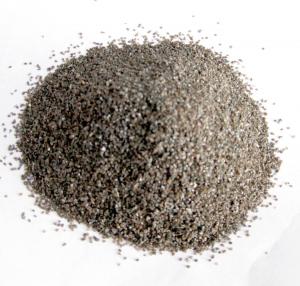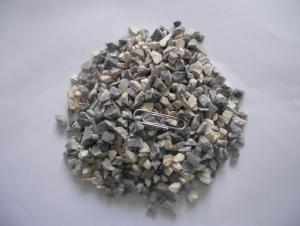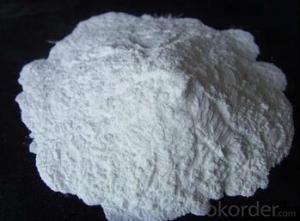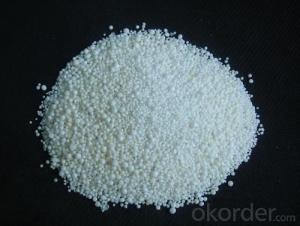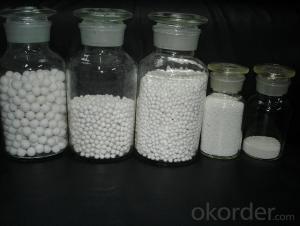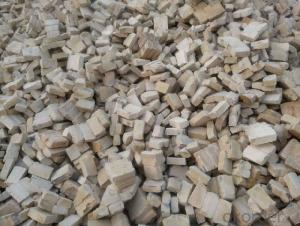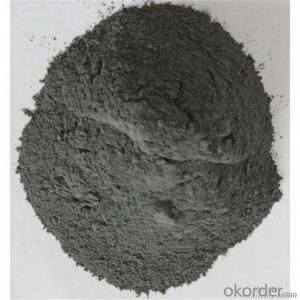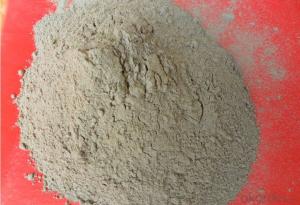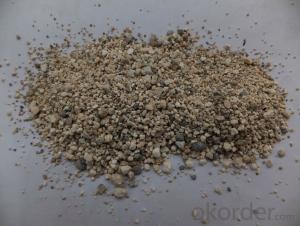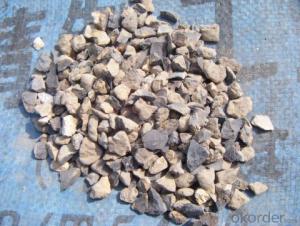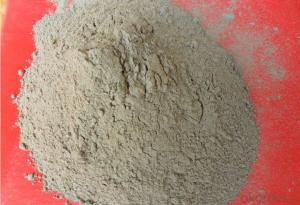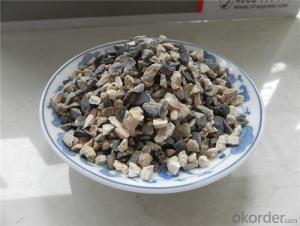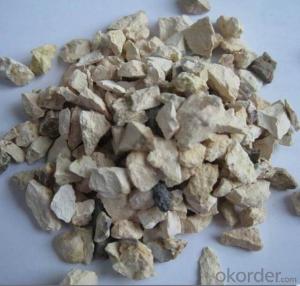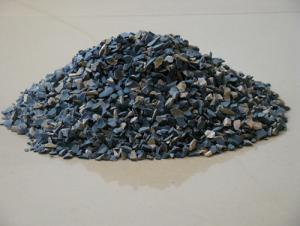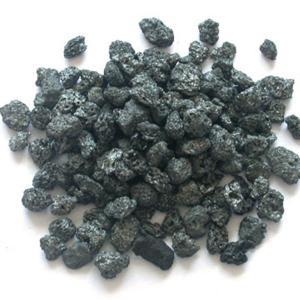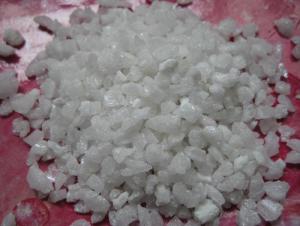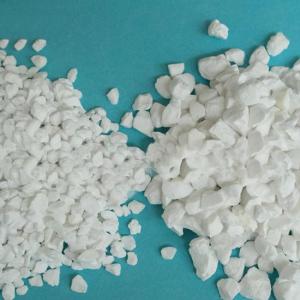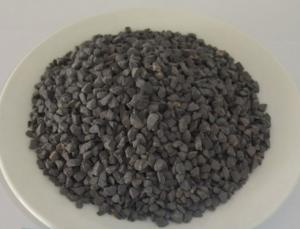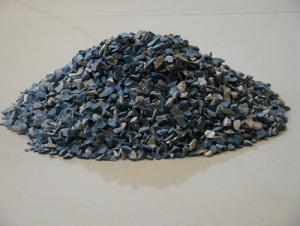Raw Materials for Refractory:High Alumina 0-1mm, 1-3mm, 3-5mm Calcined Bauxite Granular for Road Making
- Loading Port:
- China main port
- Payment Terms:
- TT OR LC
- Min Order Qty:
- 25 m.t.
- Supply Capability:
- 10000 m.t./month
OKorder Service Pledge
OKorder Financial Service
You Might Also Like
Quick Details
| Shape: | Fines (Powder) | Dimensions: | 0-1mm 1-3mm 3-5mm 60mesh | Chemical Composition: | Al2O3 |
| Concentrate Or Not: | Non-concentrate | Moisture (%): | 4% max | Al2O3 (Min): | 80%-95% |
| Place of Origin: | Liaoning, China (Mainland) | Brand Name: | cnbm | Model Number: | LMME-BUX-PD |
| color: | grey/yellow | appearance: | granule | application: | cement |
Packaging & Delivery
| Packaging Details: | After receive down payment 10 days |
| Delivery Detail: | 10 days |
Product Description
Specifications:
| Al2O3 | SiO2 | Fe2O3 | CaO+MgO | K2O+NaO | Density | TiO2 |
| 80% | 6-14% min | 2%-3% max | 0.4% max | 0.05-1% max | 2.9-3.2 | 3.5% max |
| 85% | 6-14% min | 2% max | 0.4% max | 0.05-1% max | 2.9-3.2 | 3.5% max |
| 87% | 6-14% min | 2% max | 0.4% max | 0.05-1% max | 2.9-3.2 | 3.5% max |
| 88% | 6-14% min | 2% max | 0.4% max | 0.05-1% max | 2.9-3.2 | 3.5% max |
It can be used in aluminium industry ,precision casting, refractory materials and refractory cement.
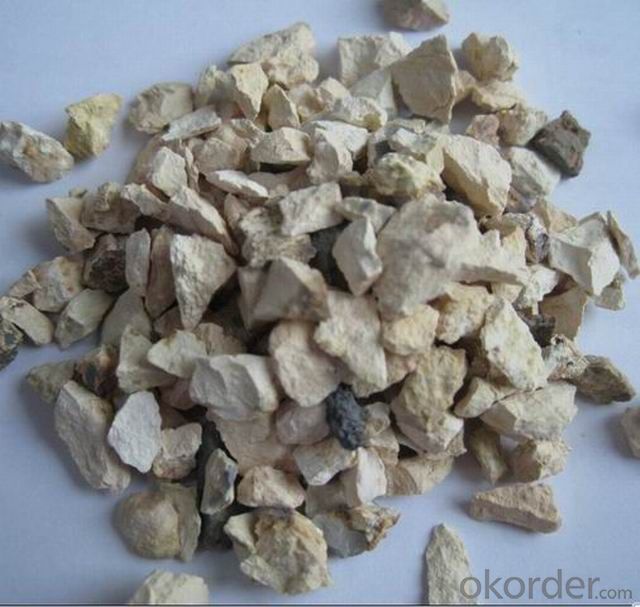
Our Services
We offer competitive price.
We provide professional product consultation.
We have precise quality control department.
We have complete customer services system.
We have export quota permit of some restrict minerals products.
We provide all kinds of certificate according to clients’ requirements.
We are willing to help clients to look for any potential products and goods.
- Q: Does anyone know the characteristics of refractory for glass kiln?
- Quartzitic sandstone. Also known as quartzitic sandstone or white gravel. Which is a kind of natural refractory and quartz sandstone bonded by the kaolinite. Who appearance is better to be steel-grey, dense and hard, free of impurities and stripes. Its main crystalline phase is mainly quartz and kaolinite. Which has obvious stratified structure and anisotropism. The refractoriness fluctuation is between 1650~1730 ℃. The expansibility of quartzitic sandstone is different from that of silica?brick, who has maximum coefficient of thermal expansion under temperatures of 700 ~ 800 ℃, and it is most likely to burst at this time. The load softening temperature and the compression strength of calcined quartzitic sandstone have been improved significantly, with small residual expansion, stable volume, better thermal shock resistance, so it is generally to use calcinated quartzitic sandstone as refractories. which has been widely used as sidewall blocks on the small and medium sized furnaces.
- Q: For refractory, what is critical particle size? Thank you.
- For example, in refractory technology, if there is an express of equal to or lower than 0.008mm, 0.008 refers to critical particle size. The main criterion for judging performance of three major continuous casting is the major three normal temperature indexes (compressive strength and anti bending strength at normal temperature, apparent porosity and bulk density). Does this criterion have any defect? How to do multiple test if high-temperature index introduced? Carbon bond is one of the three major castings. How does it form? What do you think of it? Hope someone explains it for me. Thanks a lot!
- Q: Are fire materials poisonous after burning?
- Neutral refractory is mainly composed of alumina, chromium oxide or carbon. Corundum products containing more than 95% of alumina are a kind of high quality refractory materials with a wide range of uses. Chrome brick with chromium oxide as its main component has good corrosion resistance, but its thermal shock resistance is poor, and its deformation temperature is lower at high temperature. Carbon refractories with carbon bricks, graphite and silicon carbide products, low coefficient of thermal expansion, high thermal conductivity, good thermal shock resistance, high strength, resistance to acid and salt corrosion, especially weak acid has good resistance, without wetting of the metal and slag, light. It is widely used as lining material of high temperature, and also used as lining of autoclave in petroleum and chemical industry.
- Q: Who knows the refractoriness of high temperature lightweight firebricks?
- Refractoriness refractory bricks with different melting points, the melting point is liquid and solid crystal phase at a temperature equilibrium. The vast majority of bricks are made of heterogeneous materials. No fixed melting point, it begins to appear to be melting and becomes complete liquid gradually, solid and liquid coexist over a wide temperature range, fusion and softening of refractory is messured by its performance at high temperature. Therefore, refractoriness is the temperature at which the multiphase reaches a certain degree of softening. Refractoriness is an important technical indicator in evaluating refractory bricks, but it can not be seen as the temperature ceiling. GB / T 7322 "Test Methods for high alumina brick refractoriness" alumina brick refractoriness test standards. refractoriness of some commonly used refractory bricks as follows: 1, clay brick 1610? 1750 ℃ ??2,silicon brick 1690? 1730 ℃ 3, crystalline silica 1730? 1770 ℃ 4, hard paste1750? 1770 ℃ 5, high alumina brickx26gt; 1770? 2000 ℃ 6, magnesite refractory bricksx26gt; 2000 ℃ 7, dolomite refractoryx26gt; 2000 ℃
- Q: For refractory knowledge. What is the ratio of clay ramming?mass?
- Soil aggregates, dispersing agent, water reducing agent, plasticizer, binding agent and powder! ~ Bone meal feed approximately 6, OK
- Q: What's the heat conductivity coefficient of fire-resistant material?
- 5~5 (Unit: W·m-1·K-1). The symbols are λ or K. Thermal conductivity and material properties Thermal insulation material generally is 0, and is related to organizational structure and working temperature. Thermal conductivity of the material refers to the heat transferred from from one plane to another plane in 1 seconds. Generally the thermal conductivity of fire-resistant material is 1. The larger the value is, the stronger the thermal conduction performance is. If the temperature of two planses differes for 1K, then the thermal conductivity is 03~1. The plane cover 1square meter.
- Q: The difference between refractory and thermal insulation material
- Refractory refers to inorganic non-metallic material, whose refractoriness is not less than 1,580℃, but refractory is not necessarily insulated material. Inorganic thermal insulated material also belongs to refractory as long as its refractoriness is higher than 1,580℃.
- Q: What defect does fused cast refractories have ?
- What defect doesfusion-cast refractory material have ? In glass production, in addition to refractory as a building material and consider its durability, we still must attach great importance to its influence on glass quality. In such cases, the impact on the quality of glass is mainly the defects that eroded down refractory materials mixed in the glass, thus being prodeced of grass products. Defects are mainly foreign body defects such as sand, knot and wave reinforcement. What may directly affect the quality of glass are sidewall block and brick kiln bottom. I hope my answer can help you.
- Q: Does anyone know fire-proof material of fireproof wooden door?
- Fireproof wooden door goes through the flame treatment, so it can prevent fire. Its principle: Fire-retardant treated timber has become flame retardant material itself and its fire endurance has increased. The commonly used method of fire retardant treatment for timber including: Spraying method, soaking method, boiling method, vacuum method, vacuum-pressure method. Spraying method and soaking method are generally used for timber surfaces which are no longer going through planing process, and thin plate fire retardant treatment, whose thickness is less than 10mm .
- Q: What are the advantages of refractory material?
- Jingute WHL type, GDS type
Send your message to us
Raw Materials for Refractory:High Alumina 0-1mm, 1-3mm, 3-5mm Calcined Bauxite Granular for Road Making
- Loading Port:
- China main port
- Payment Terms:
- TT OR LC
- Min Order Qty:
- 25 m.t.
- Supply Capability:
- 10000 m.t./month
OKorder Service Pledge
OKorder Financial Service
Similar products
Hot products
Hot Searches
Related keywords
